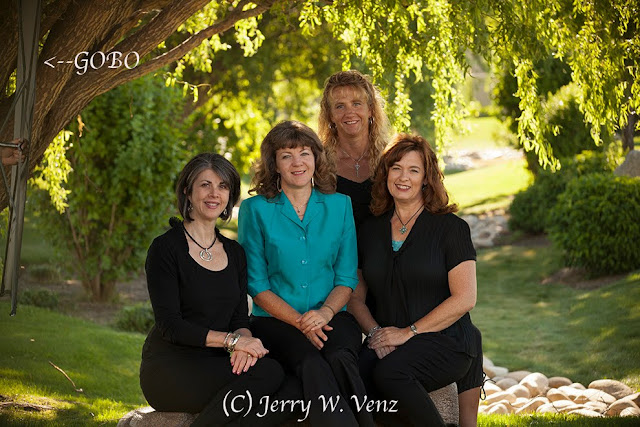It’s easy doing portraits outside near the “magic hour." Here in Idaho we often start up to two hours before sunset and, with proper subject placement, create wonderful natural light portraits with NO reflectors or supplemental flash (Yuck!).
I learned, over 30 years ago, from Leon Kennamer—the Master Photographer that developed subtractive lighting for portraits—that there’s no need for reflectors or supplemental flash if you know how to control natural light with Gobos (Black Flats or flags as we called them in film making). The basic premise being: when you have the light it’s silly, and unnatural looking, to add light! Adding light tends to just create flat light that deletes shadows and without any shadows you lose the three dimensionality in your subject(s).
I’ll start with a worst case lighting scenario. Here we have a nice little park with a couple of large weeping willow trees, but it’s 9AM and there’s intense light all around us.
 |
| f6.3 @ 1/125 sec., ISO 400; Lens @ 142mm |
- The first step is to get them in the shade of that tree! I trimmed some of the tree’s hanging vines on the right leaving the vines on the left to help in the subtractive process.
- Then we bring in our Gobo (a 42” Black Flat) to block as much light as we can from the left.
Here’s the scene without the Gobo….
 |
| No Gobo |
As you can see this single Gobo is most effective on the people closest to it. The single Gobo is very effective for individual portraits where you can bring it in very close to the subject…
 |
|
f4.5 @ 1/250 sec., Iso 400; Lens @ 185mm
|
Done at 9:11AM in the same spot as the group portrait you can see the natural looking, three dimensional, effect subtractive lighting creates.
NATURAL GOBOS:
My preferred method of subtractive lighting is to use Large Natural Gobos on locations I use regularly for group portraits. These natural Gobos can be a tree line, rocks, or large bushes to one side of the group.
The Key here is Subject Placement….
 |
|
f6.3 @ 1/160 sec., ISO 400; Lens @ 105mm
|
Leon Kennamer taught that, “The Light is at the Edge of the Forrest ”. That means that you place your subject literally at the edge of the tree canopy, but still in the shade. That way we can get good Directional Light from a large patch of sky.
In the above portrait I’ve placed this group so that the tree line on Camera Left is my Gobo creating the Shadows on their faces while a large patch of blue sky on Camera Right is the Key Light.
This portrait was done 2-hours before sunset so that my backlit background is under control. Subtractive lighting is actually a very simple concept; its execution only requires that you be able to see the directional light and the shadows it creates when you have an effective GOBO.
The concept here is fundamental in the traditional art world; Leonardo da Vince wrote…
“ The Artist who can make his subject appear to be in relivo (made to appear to have elevation, with depth and dimension) is he who should receive the greatest praise! ”
Go our and try it! If you have questions don’t hesitate to ask…’Til next week.
Author: Jerry W. Venz, PPA Master Photographer, Craftsman
Training site: http://www.LightAtTheEdge.com
Client site: http://www.TheStorytellersUsa.com